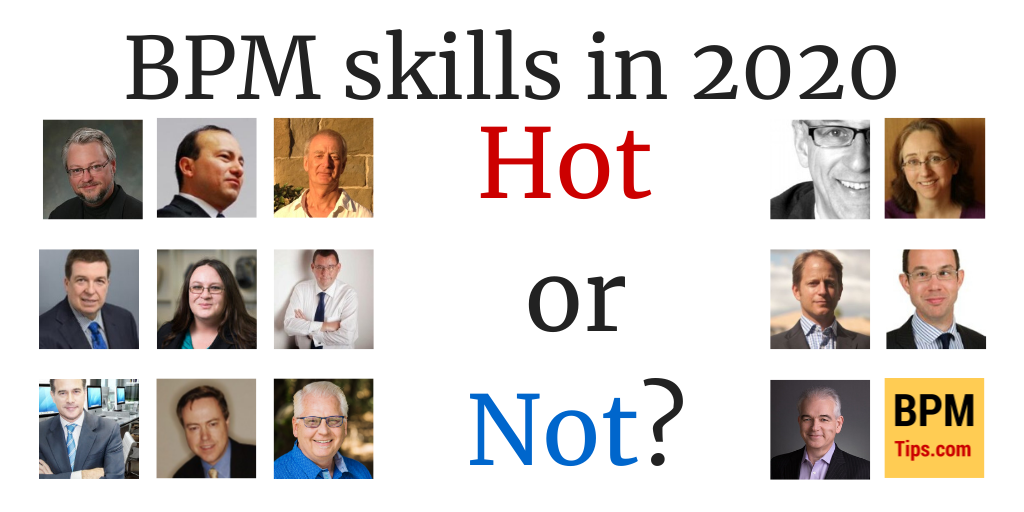January is often time when we come up with resolutions for a new year. While it is easy to decide that we want to change something, change will not happen unless we start doing something differently.
That’s why, like in the past years, I prepared for you post with suggestion regarding skills which will be useful for process professionals.
You can also check the 2019, 2018, 2017 part 1, 2017 part 2, and 2016 version of this post.
You will notice that there are some small changes in questions this year, but the answers should give you suggestions regarding our main topic i.e.
Which BPM skills will be hot in 2020?
First part of this post contains answers from 10+ BPM experts. You can either read everything or use the navigation below. Enjoy and stay tuned for part 2!

Lloyd Dugan
Marlon Dumas
Alan Fish
Ian Gotts
Sandy Kemsley
Mathias Kirchmer
Holly Lyke-Ho-Gland
Juergen Pitschke
Brian Reale
Adrian Reed
Pedro Robledo
Phil Simpson
Jim Sinur
James Taylor
Now, let’s dive into the answers.
Lloyd Dugan
 Lloyd Dugan is a widely recognized thought leader in the development and use of leading modeling languages, methodologies, and tools, covering from the level of EA and BA down through BPM, Case Management, and SOA. He specializes in the use of standard languages for describing business processes, systems, and services, particularly BPMN, CMMN, and DMN from the OMG. He has developed and delivered BPMN 2.0 training to the U.S. Department of Defense and large consultancies. He has nearly 30 years of experience with public and private sector clients, and has an MBA from the Fuqua School of Business at Duke University. He is an OMG-Certified Expert in BPM (OCEB) – Fundamental, a member of the Workflow Management Coalition and its BPSim Working Group, a member of the OMG’s BPMN Model Interchange Working Group (MIWG), and a Contributing Member (author), Meta Modeling and BPM-BA Alignment Collaboration Teams Member, and Advisory Board Member of the Business Architecture Guild. He is a frequent speaker at national and international conferences on BPM, BPMN, Case Management, SOA, and BA. He is a published author or co-author on BPM, BPMN, and BA. He serves as the Chief Architect for Business Process Management, Inc. (see www.bpm.com), for whom he delivers BPM-related training and client advisory services on BPM-related matters and technologies.
Lloyd Dugan is a widely recognized thought leader in the development and use of leading modeling languages, methodologies, and tools, covering from the level of EA and BA down through BPM, Case Management, and SOA. He specializes in the use of standard languages for describing business processes, systems, and services, particularly BPMN, CMMN, and DMN from the OMG. He has developed and delivered BPMN 2.0 training to the U.S. Department of Defense and large consultancies. He has nearly 30 years of experience with public and private sector clients, and has an MBA from the Fuqua School of Business at Duke University. He is an OMG-Certified Expert in BPM (OCEB) – Fundamental, a member of the Workflow Management Coalition and its BPSim Working Group, a member of the OMG’s BPMN Model Interchange Working Group (MIWG), and a Contributing Member (author), Meta Modeling and BPM-BA Alignment Collaboration Teams Member, and Advisory Board Member of the Business Architecture Guild. He is a frequent speaker at national and international conferences on BPM, BPMN, Case Management, SOA, and BA. He is a published author or co-author on BPM, BPMN, and BA. He serves as the Chief Architect for Business Process Management, Inc. (see www.bpm.com), for whom he delivers BPM-related training and client advisory services on BPM-related matters and technologies.
WWW: BPM.com
WWW: LI profile
What are the skills, techniques, behaviors, and attitudes that can help BPM practitioners create value for their organizations in 2020?
As the discipline of Business Architecture matures, BPM Practitioners will need to improve their understanding of process modeling, because it’s not just boxes and arrows anymore when BPM Projects must show and maintain alignment with the management of business capabilities towards achieving strategic goals. The full spectrum of operational modeling languages (BPMN/CMMN/DMN) must be better understood and used correctly along with related business architecture models. in addition, as RPA and ML ascend and mature past 1st gen technologies, BPM Practitioners must embrace new design patterns as part of their solution set (e.g., not trying to “fix” legacy processes and systems if unattended RPA can be used to automate the automation). Finally, BPM Practitioners need to take what they are doing seriously as a true professional discipline and demonstrate that seriousness to their customers. It is not merely Business Analyst work, and should not be delivered at a 1-800-BPM4YOU level.
What are the best resources to learn those skills? (e.g. books, articles, courses)
Academic-wise, I recommend an MBA, but this is not the only way. Find a mentor, and see the job as an apprenticeship on the way to being a master practitioner. Books are good, but they are only a start. Find a community of shared interest, take training in specific skill sets, etc. IT is a profession to invest in, not just a job. (Booyah!). 👍
Which skills are no longer relevant or not practically applicable yet (hype)?
With so-called low-code/no-code platforms becoming more ubiquitous by the day (and App Dev Platform the term du jure instead of BPMS or Case Mgmt Sys Platform), understanding and applying good UX design and screen flow principles are being under-emphasized, so skills are weakening just as RPA needs analysts who understand these things as part of automated process design. Both attended and unattended RPA need BPM Practitioners to help in modeling RPA design flows (which should otherwise be familiar territory to those experienced with using automated functional testing tools).
Prof. Marlon Dumas
 Marlon Dumas is Professor of Information Systems at University of Tartu, Estonia, and co-founder of Apromore Pty Ltd, a company dedicated to developing and delivering open-source process mining solutions. He is currently recipient of an Advanced Grant from the European Research Council with the mission of developing algorithms for automated identification and assessment of business process improvement opportunities from event data. His research in the field of business process management and process mining has led to numerous research publications, several US/EU patents, and a textbook (Fundamentals of Business Process Management) used in over 250 universities worldwide.
Marlon Dumas is Professor of Information Systems at University of Tartu, Estonia, and co-founder of Apromore Pty Ltd, a company dedicated to developing and delivering open-source process mining solutions. He is currently recipient of an Advanced Grant from the European Research Council with the mission of developing algorithms for automated identification and assessment of business process improvement opportunities from event data. His research in the field of business process management and process mining has led to numerous research publications, several US/EU patents, and a textbook (Fundamentals of Business Process Management) used in over 250 universities worldwide.
WWW: WWW
WWW: LI profile
What are the skills, techniques, behaviors, and attitudes that can help BPM practitioners create value for their organizations in 2020?
Customer experience will continue to be a driving force well into 2020. BPM practitioners will be pressed to remain focused on heightening perceived service quality, delighting the customer, enhancing customer engagement, and driving revenue by converting customer engagement into revenue growth. In this golden age of the customer, we will continue to see increased adoption of techniques and tools to analyze, monitor, and improve customer-facing processes, to unearth issues, bottlenecks, and constraints that affect customer experience, and to drill down into root causes of customer dissatisfaction . Adoption of data analytics, process mining, and AI techniques will continue to gain traction, particularly those that directly allow one to create “wow” moments for the customer and to convert customer engagement into revenue growth, including recommender systems, predictive and prescriptive process analytics, and automated root-cause analysis.
And last but not least: As we deal with customer data, in particular for process mining, BPM practitioners should keep an eye on privacy issues, especially as GDPR enforcement is gaining traction.
What are the best resources to learn those skills? (e.g. books, articles, courses)
BPM Practitioners need to further develop their skills in machine learning, particularly project execution. Classic MOOCs and books on machine learning are worth having on one’s digital bookshelf. For example, the book “Machine Learning Yearning” by Andrew Ng is a good starting point.
An easy-to-read introduction into AI for customer experience is “The Age of Intent” by Kanan and Bernoff, although one should read beyond the book’s focus on chatbots. Another book worth the read for BPM Practitioners is “Connected Strategy” by Siggelkow and Terwiesch. There are interesting and useful links to be made between the concept of “connected strategy” and process mining, analytics and AI adoption strategy.
Which skills are no longer relevant or not practically applicable yet (hype)?
The dust has settled on the blockchain front, after the unfortunate mega-hype of the past three years. This is not to say that blockchain is not relevant. It is and will remain relevant within its scope – as a trust-enhancing technology, for example to implement auditability and verifiability requirements in business processes.
Alan Fish
 Dr Alan N Fish is Principal Consultant in Decision Solutions with FICO, having over 30 years’ experience in the support, automation and optimisation of organisational decisions. He invented the “Decision Requirements Diagram” (DRD) which exposes the structure of a domain of decision-making, and developed Decision Requirements Analysis (DRA): a methodology for building and using such decision models. He is the author of “Knowledge Automation: How To Implement Decision Management in Business Processes” (Wiley), and co-author of the OMG specification Decision Model and Notation (DMN).
Dr Alan N Fish is Principal Consultant in Decision Solutions with FICO, having over 30 years’ experience in the support, automation and optimisation of organisational decisions. He invented the “Decision Requirements Diagram” (DRD) which exposes the structure of a domain of decision-making, and developed Decision Requirements Analysis (DRA): a methodology for building and using such decision models. He is the author of “Knowledge Automation: How To Implement Decision Management in Business Processes” (Wiley), and co-author of the OMG specification Decision Model and Notation (DMN).
WWW: http://www.fico.com
WWW: LI profile
Twitter: @AlanNFish
What are the skills, techniques, behaviors, and attitudes that can help BPM practitioners create value for their organizations in 2020?
I’m glad that Zbigniew has included “attitudes” in this question, since a shift in attitude is required for successful BPM.
Considered as a decision-making entity, an organisation is much more complex than is assumed by most BPM practices. It is an information ecosystem: a complex network of many decision-makers – individuals, groups and automata – passing information to each other. Ecosystems are notoriously hard to model: they are complex and adaptive.
To address the complexity, the practitioner must recognize that it is not enough to model processes; s/he must model at least processes, case management, decisions and data. This can be done using the OMG “Triple Crown” (BPMN, CMMN and DMN), supported by UML. These detailed models will show how decisions are partitioned over time and between decision-makers, and will identify the key “meta-decisions”: decisions about how decisions should be made.
To address adaptivity, the practitioner must recognize that repeated process reengineering is a costly and unreliable way to achieve ongoing change in an organisation. Successful organisations are those which adopt models of decision-making where adaptivity is achieved through changes to discrete Business Knowledge Models, i.e. through decision management. This requires an initial reengineering effort to identify, automate and expose areas of business knowledge so that these can be updated and optimised over time (e.g. using analytics) without further changes to process.
What are the best resources to learn those skills? (e.g. books, articles, courses)
These ideas are described in more depth in a paper I gave to the DecisionCAMP 2019 conference: https://decisioncamp2019.files.wordpress.com/2019/09/dc2019.alanfish-1.pdf. Also read my book Knowledge Automation, any books about the standards BPMN, CMMN and DMN, and the standards themselves.
Which skills are no longer relevant or not practically applicable yet (hype)?
Real skills never become irrelevant.
Ian Gotts
 Ian is a founder of Elements.cloud, tech advisor, investor, speaker and author.
Ian is a founder of Elements.cloud, tech advisor, investor, speaker and author.
Elements.cloud helps customers clean-up, document and build their app implementations, focused on Salesforce. But valid for any low code app platform, esp as the process mapping is free, for ever, for everyone.
WWW: https://medium.com/@Q9ELEMENTS
WWW: elements.cloud
WWW: LI profile
Twitter: @iangotts
What are the skills, techniques, behaviors, and attitudes that can help BPM practitioners create value for their organizations in 2020?
We launched OrgConfessions.com where Salesforce users could post their anonymous implementation horror stories. Salesforce is the #1 low-code app platform with 300,000 customers. The confessions are truly horrific and a symptom of low-code apps with citizen developers so it is directly relevant to the BPM community. The root cause analysis of over 600 confessions is insightful as it shows the key skills gaps. The top 4 are:
Business Analysis; process mapping, requirements capture & developing user stories
Project architecture; architecting the right solution and data modeling
Documentation and naming standards; documenting the changes that were made to reduce technical debt and ongoing impact analysis
Change management methodology; following a clearly defined methodology that reduces delivery risk, increases agility and drives business benefits.
Sandy Kemsley
 Sandy is a “technology catalyst” with a 20-year history of software design and systems architecture in several technology areas, combined with a deep understanding of business environments and how technology can impact them.
Sandy is a “technology catalyst” with a 20-year history of software design and systems architecture in several technology areas, combined with a deep understanding of business environments and how technology can impact them.
She has also founded and run three companies – a systems integration services company, a software product company, and current consulting company – with responsibility for corporate and financial governance, strategic direction, team hiring and management, and day-to-day technical contributions.
Sandy blogs about BPM, enterprise architecture and other intersections of business and technology at www.column2.com
WWW: https://column2.com
WWW: LI profile
Twitter: @skemsley
What are the skills, techniques, behaviors, and attitudes that can help BPM practitioners create value for their organizations in 2020?
There is a strong need to be able to fit what we do in BPM systems (which is often at the level of task management with some functional process KPIs thrown in) with the larger picture of our organization’s business architecture and goals. I wrote recently about the need for goal alignment throughout the organizational hierarchy (https://www.trisotech.com/blog/the-need-for-goal-alignment), tracing from the corporate purpose, to business capabilities (the services provided to customers), to business functions (internal processes), to individual tasks. The KPIs at the lower levels of the organization should always be directly traceable to higher-level KPIs in order to ensure goal alignment at all levels in the organization. Without this alignment, the performance measures at the lower operational levels – particularly those focused on individual rather than team performance such as transaction counts – can end up working against the higher-level corporate business requirements. Equally important, if a corporate-level KPI can’t be traced down to a lower-level operational KPI, there may not be any actual work being done to achieve those corporate goals.
What this means for BPM practitioners is a greater awareness of goals and KPIs within different levels of their business architecture. This doesn’t mean having to become certified in some obscure business architecture methodology, or perform a months-long modeling exercise; rather, just a specification and alignment of KPIs at each level of the hierarchy. Once these have been identified, and the KPIs at each level linked to those in the hierarchy both above and below them, then the most relevant performance metrics for processes and tasks can be extracted for use in BPM models and systems.
What are the best resources to learn those skills? (e.g. books, articles, courses)
There are a lot of online resources for goal alignment, but I have presented some fairly simple techniques and an example in the article linked above. Several of the resources that I have seen online are from the standpoint of HR systems and talent management, where the focus is on ensuring that individual KPIs are aligned with higher-level corporate goals; I suggest that a more comprehensive view is required, with KPIs traced in both directions through the hierarchy.
The best way to learn and master the skill of identifying and linking hierarchies of KPIs is to actually do it within your organization. Use some simple charts to collect the KPIs at different levels, then use online collaboration or an in-person workshop to look at traceability between the KPIs. I guarantee that there will be some “a-ha” moments as different people in your organization realize that they’re measuring the wrong thing, or expecting results that can never happen because of how other areas are measured.
Which skills are no longer relevant or not practically applicable yet (hype)?
Some forms of data collection and analysis are becoming obsolete in the face of intelligent technologies such as process mining and AI. For example, it’s not necessary to manually collect information on how a person uses a specific system if the system produces history logs that can be analyzed using processing mining, although it will still add value to see what manual tasks that they perform while using the system.
Dr. Mathias Kirchmer
 Dr. Kirchmer is an experienced practitioner and thought leader in the field of Digital Transformation and Business Process Management (BPM). He co-founded BPM-D, a consulting company focusing on digital process transformation, operational excellence and customer experience by leveraging the discipline of BPM. Before he was Managing Director and Global Lead of BPM at Accenture, and CEO of the Americas and Japan of IDS Scheer, known for its ARIS Process Software.
Dr. Kirchmer is an experienced practitioner and thought leader in the field of Digital Transformation and Business Process Management (BPM). He co-founded BPM-D, a consulting company focusing on digital process transformation, operational excellence and customer experience by leveraging the discipline of BPM. Before he was Managing Director and Global Lead of BPM at Accenture, and CEO of the Americas and Japan of IDS Scheer, known for its ARIS Process Software.
Dr. Kirchmer has led numerous transformation and process improvement initiatives and has worked with hundreds of clients in technology, financial, health, consumer goods and manufacturing industries. He has published 11 books and over 150 articles. He is affiliated faculty at the University of Pennsylvania and received a research and teaching fellowship from the Japan Society for the Promotion of Science.
WWW: LI profile
WWW: http://bpm-d.com
Twitter: @mtki2006
What are the skills, techniques, behaviors, and attitudes that can help BPM practitioners create value for their organizations in 2020?
Here are five key skills I see for 2020 in the field of business process management (BPM):
* Digital Transformation – Creating Value through Process: The value of digital transformations is realized through new or significantly improved processes. Hence, BPM is a main enabler for successful digitalization initiatives. This requires the skill of integrated process analysis and design, to align digital technologies, people, and physical products to provide best value in the context of a specific business strategy. Transformation results are sustained through an ongoing Process of Process Management. Therefore the skills to set-up and run such a BPM-Discipline are important.
* BPM 4.0 – Powered by Digital Accelerators: Organizations establish the fourth generation of BPM, powered by digital accelerators, like integrated modelling and simulation tools, process mining, eLearning or digital transformation management tools. The new and enhanced BPM capabilities deliver significant value by simplifying and aligning processes with strategic goals – fast and at minimal risk. Therefore organizations need to build up skills not only in the use of such digital process management tools but in combining them to achieve best outcomes.
* Smart Automation – Business-centric and Agile: Business-outcomes are achieved by combing the appropriate automation components, such as workflow automation, robotic process automation (RPA), optical character recognition (OCR), machine learning (ML) or other artificial intelligence (AI) components, and traditional applications. This is about systematically automating business processes in an end-to-end context, delivering quick results through agile approaches. Digital software-based process reference models help to understand and plan the business impact of the automation and enable a rapid and standardized roll-out of digital processes. This requires skills in those automation technologies as well as in the business-driven combination, including the development and use of digitalization reference models.
* Stakeholder Experience – an Outside-in View through Integrated Journey Planning: An outside-in view on processes to identify the most relevant improvement objectives becomes an important part of transformation initiatives. Journey mapping approaches, integrated with underlying business processes, are enablers. Customer journey planning as well as supplier or employee journey maps are increasingly used to achieve best experience of key stakeholders of an organization. This requires journey mapping skills as well as skills to integrate those maps with underlying processes and improve them appropriately.
* Process Governance – People are Key: The limiting factor for increasing process performance are people – not digital technologies. Process governance provides the necessary guidance and the right degree of freedom for people to realize their full potential. This is necessary to resolve complex exception cases, align people and robots through hybrid workforce management and keep processes on track. Process governance defines the right roles, responsibilities and governance processes. Digitalization and the volatile business environment force organizations to put more emphasis on this topic and build appropriate skills.
What are the best resources to learn those skills? (e.g. books, articles, courses)
* A good overview over the topics mentioned is provided by industry organizations, like ABPMP or the BPM-Institute, and by specialized service firms like BPM-D. It is worth to compare training and education agendas to come up with the right mix.
* There are more and more eLearning offerings available covering at least some of those topics, such as the module “Strategy Execution in a Digital World: The BPM-Discipline” from BPM-D.
* A deeper and more comprehensive education in many of the areas mentioned is provided by academic institutions, such as Widener University (Master in Business Process Innovation) or the University of Pennsylvania (Program of Organizational Dynamics in the School for Arts and Sciences).
* In addition there are first books available covering those topics, such as “High Performance through Business Process Management – Strategy Execution in a Digital World” or “The Drivers of the Digital Transformation”.
Which skills are no longer relevant or not practically applicable yet (hype)?
I think many of the traditional statistical improvement tools and related traditional approaches, like e.g. Six Sigma, will continue to lose traction since their application in the office environment is too slow for the digital world.
Holly Lyke-Ho-Gland
 Building on more than 10 years of business research and consulting experience, Holly Lyke-Ho-Gland is a principal research lead who conducts and publishes APQC research on process management and improvement, quality, project management, measurement, and benchmarking for APQC’s Process and Performance Management research team. Her research supports APQC members and clients across disciplines and centers on helping professionals and project managers solve business problems with strategy, process and measurement.
Building on more than 10 years of business research and consulting experience, Holly Lyke-Ho-Gland is a principal research lead who conducts and publishes APQC research on process management and improvement, quality, project management, measurement, and benchmarking for APQC’s Process and Performance Management research team. Her research supports APQC members and clients across disciplines and centers on helping professionals and project managers solve business problems with strategy, process and measurement.
Holly regularly partners with other APQC research leads to look at improving the end-to-end business processes in areas such as procure-to-pay or order-to-cash where true improvement rests in the entire process versus one functional department. On a biannual basis, she conducts APQC’s extensive research survey and report on The Value of Benchmarking as well as annual surveys and reports on how organizations adopt and use the Process Classification Framework®.
WWW: https://www.apqc.org
WWW: LI profile
Twitter: @hlykehogland
What are the skills, techniques, behaviors, and attitudes that can help BPM practitioners create value for their organizations in 2020?
People skills are essential. Year-over-year the biggest challenges unearthed in our annual priorities survey are people challenges—buy-in, resistance, and culture. While so much relies on technology solutions these days, we can’t lose sight of the fact that everything we do in BPM still has a human element. Hence change skills and engagement remain some of the most relevant skills for practitioners in 2020.
We also conducted a study on the people of process and they identified the following four skills as must develops over the next 18 months:
1. Human-centric Design—techniques like design thinking and ethnography which are founded on the idea that people design products and services and don’t know what the client really wants or needs. Hence organizations can use empathic design methods like observation, interviews, immersion, and guiding concepts to link unknown or intangible needs with the organization’s capabilities and provide optimal customer or end-user value.
2. Innovation—the capacity for innovation is the ability to quickly recognize and address emerging needs and opportunities. Individuals with this competency also have the agility to learn and apply methodologies—like design thinking, systems thinking, and adaptive leadership—for a structured approach to innovation.
3. Technology Fluency—the understanding of new and emerging technologies. This does not mean you have to be able to create them but understand their features and applications as well as their limitations.
4. Data Management—is a blanket term for the management of the entire data lifecycle in an organization, including governance, integrity, and warehousing. This is also the biggest technology challenge that organizations face and it’s of vital importance because as we move to data-driven decision making we must ensure we have accessible, high-quality data to use in analytics and to support technologies like automation and machine learning or AI.
What are the best resources to learn those skills? (e.g. books, articles, courses)
There are so many options available to fit everyone’s learning style. In the same study we found that people tend to rely predominantly on three resources: formal training programs, certification programs (mainly Lean, Six Sigma, or project management), and online continuing education courses (for “newer” skills and methodologies like UX design, customer journey mapping, and machine learning).
Which skills are no longer relevant or not practically applicable yet (hype)?
Personally, don’t like to think that any skill is irrelevant, just not a fit for the current project. That said in the people of process study the majority of respondents indicated that software development and programming skills were unnecessary for their work. In the early days of automation and AI work there was an initial influx of process professionals looking into developing these skills. However, vendors have taken steps to develop low code or plug-and-play software that requires processes and business rules understanding, rather than in-depth coding.
Juergen Pitschke
 Juergen Pitschke is Partner and Managing Director at Process Renewal Group Deutschland.
Juergen Pitschke is Partner and Managing Director at Process Renewal Group Deutschland.
Juergen has more than 25 years industrial experience about enterprise modelling and the realization of Business and IT Architectures. He is recognized for his deep knowledge and the systematic use of visual standard notations and of different frameworks für the design of an Enterprise Architecture. His knowledge is often sought in the field of Business Process Management and Decision Management.
His focus are model-based approaches for enterprise design and their practical use. Clients value his abilities to explain concepts, to help teams to adopt and successfully apply such methods, and to guide projects successfully.
He is author of the book “Unternehmensmodellierung für die Praxis”. He translated the Business Process Manifesto, the Decision Management Manifesto, and the RuleSpeak® – approach into German.
His customers include companies as Kuehne+Nagel (AG & Co.) KG, Boehler Edelstahl or organizations like the Federal Office of Police in Switzerland.
WWW: http://processrenewal.de
WWW: LI profile
Twitter: @jpitschke
What are the skills, techniques, behaviors, and attitudes that can help BPM practitioners create value for their organizations in 2020?
Modelling is an important skill in Business Process Management. This stays valid. But Modelling is not management. As John Zachman always says: “If you can’t describe it, you can’t build it.” It is the base and must be accompanied with many other skills and techniques.
After describing the business processes and business decisions it is not only important to implement and automate. We also need to measure for all kind of views. Measure the performance, in implementing and automation we have to define the priority, we have to classify for risk. The list goes on. Depending on our project charter we classify and manage for very different views.
Accordingly notations showing the relationships between business process management, business decision and very different views are more popular in the customer base. In the same direction tools develop more and more into architecture tools offering features for describing the needed artefacts and features for analyzes, implementation and simulation and so on. Do we still need “pure” BPM tools? Or are the market and the needed skills changing (merging with?) to architecture management?
Classification of business processes, business decisions and other artefacts is important. See my blog post “Classify, Classify, Classify, …” from October. Finding good classifications supports prioritization and other tasks.
What are the best resources to learn those skills? (e.g. books, articles, courses)
Roger Tregear, Reimagining Management: Putting Process at the Center of Business Management ISBN 978-0-6480049-0-5
If you didn’t read it before, I suggest you take the chance. Maybe it turns into a classic. Especially the PO and PI circle is appealing. What do we do to improve if our current process seems to be perfect and no further improvement can be seen?
In the field of Business Decision Management you find some updates.
E.g. for the “Business Decision Management Manifesto (see http://www.decisionmanagementsolutions.com/what-is-decision-management/the-decision-management-manifesto/) and the book from James Taylor (“Digital Decisioning” ISBN 978-0-929652-64-1). Both reflect news in the application of Business Decision Management in the light of Artificial Intelligence.
As said before using standard notations is a benefit. I see more often that customers just use an element from an existing notation because it has a nice name and use their own meaning. They define their own notation. Doing so you lose the benefits of the standard notations. Using elements e.g. from TOGAF and Archimate requires some work and learning. For TOGAF/Archimate you find a rich literature from The Open Group®. For the OMG-standard notations you find a rich literature too.
Which skills are no longer relevant or not practically applicable yet (hype)?
I had big hopes for CMMN two years ago. I still think it is important. But it seems it is only used by some tool vendors and users.
Brian Reale
 Brian Reale is a serial entrepreneur. Brian founded a telecommunications company in 2000 called Unete Telecomunicaciones which provided, voice, data, and satellite services in Latin America. Brian sold Unete to a publicly traded US telecom company in 2000. Brian was also the co-founder of Spotless LLC, an entertainment technology company that developed projection mapping technology for major live entertainment industries.
Brian Reale is a serial entrepreneur. Brian founded a telecommunications company in 2000 called Unete Telecomunicaciones which provided, voice, data, and satellite services in Latin America. Brian sold Unete to a publicly traded US telecom company in 2000. Brian was also the co-founder of Spotless LLC, an entertainment technology company that developed projection mapping technology for major live entertainment industries.
Brian has been involved in the workflow and BPM industry since he co-founded ProcessMaker in 2000. ProcessMaker is a leading open source BPM suite which has just released its 4th generation product – a modern lightweight BPM designed for both human tasks and microservices orchestration. The ProcessMaker BPMS has been recognized with numerous awards and pushes the bounds of BPM with a fundamental belief that process management can be simple, elegant, and easy to use.
Brian graduated magna cum laude from Duke University in 1993 and was awarded a Fulbright scholarship in linguistics in Ecuador in 1994.
WWW: https://www.processmaker.com
WWW: LI profile
Twitter: @breale
Twitter: @processmaker
What are the skills, techniques, behaviors, and attitudes that can help BPM practitioners create value for their organizations in 2020?
1. ML/AI– Machine learning will grow significantly in 2020. High volume processes can see great returns from AI that is used to automate the decision making process. The objective is to reduce the requirements for humans to be involved in decision making. If a business can clearly see that a purchase request gets approved 99.5% of the time under XY and Z conditions, then it should use ML to automate that decision point. The efficiency gains from such improvements will be significant.
2. RPA – RPA and BPM will begin to consolidate. In fact, it is already happening. This will accelerate. Although technology has gotten more and more specialized, IT budgets have not grown significantly and hence cannot handle so many new tools from a cost perspective. Consolidation can help vendors deliver more value at a lower cost to customers. Customers will not want to continue buying RPA and BPM from separate vendors.
3. Low Code – Everyone will continue to push to position their suite as low code. However, customers are starting to realize that pure low code suites have a lot of drawbacks. Developers are not dead or dying…not in 2020. Pure low code tools will continue to deliver poor UI and system flexibility which will mean Low Code tools that offer an experience both for business analysts and developers will thrive. The operative term will be “Low Code Delivery Model” meaning that Business Analysts don’t deal with code but can assign certain types of work to developers when and if desired.
4. Microservices and event-driven architectures – This will continue to grow in 2020. There is a lot of legacy code and legacy BPM suites in the market. Many have not been renewed and are not based on true event-driven architectures. Customers will begin to demand new architectures that scale and deliver a true micro services experience.
What are the best resources to learn those skills? (e.g. books, articles, courses)
The RPA vendors are doing a great job of opening up their learning platforms. They will push traditional BPM, Rules, and other vendors to do the same.
Which skills are no longer relevant or not practically applicable yet (hype)?
As I said last year, RPA will not replace BPM. RPA will continue to generate disillusionment in 2020 because of the hype these toolsets have created. However, consolidation between BPM and RPA has the possibility of delivering true results.
Adrian Reed
 Adrian Reed is a true advocate of the analysis profession. In his day job, he acts as Principal Consultant and Director at Blackmetric Business Solutions where he provides business analysis consultancy and training solutions to a range of clients in varying industries. He is a Past President of the UK chapter of the IIBA® and he speaks internationally on topics relating to business analysis and business change. Adrian wrote the 2016 book ‘Be a Great Problem Solver… Now’ and the 2018 book ‘Business Analyst’
Adrian Reed is a true advocate of the analysis profession. In his day job, he acts as Principal Consultant and Director at Blackmetric Business Solutions where he provides business analysis consultancy and training solutions to a range of clients in varying industries. He is a Past President of the UK chapter of the IIBA® and he speaks internationally on topics relating to business analysis and business change. Adrian wrote the 2016 book ‘Be a Great Problem Solver… Now’ and the 2018 book ‘Business Analyst’
You can read Adrian’s blog at http://www.adrianreed.co.uk and follow him on Twitter at http://twitter.com/UKAdrianReed
WWW: http://www.adrianreed.co.uk
WWW: LI profile
Twitter: @UKAdrianReed
What are the skills, techniques, behaviors, and attitudes that can help BPM practitioners create value for their organizations in 2020?
My background is business analysis, so I suspect I’ll come at this question from a slightly different perspective compared to some of the other contributors. For me, the skills, behaviors and attitudes are largely unchanged; the increasing challenge is to select relevant techniques and adapt our practice to the specific organizational context that we find ourselves in. There was perhaps a time when a lot of what we did could be guided by “standard best practice”. There is still a place for utilizing elements of carefully cultivated “tried and tested” practice, of course, and I’m certainly not advocating re-inventing the wheel. However, more and more I am finding the art is for us as practitioners to adapt our methodology and carefully select our methods and tools and techniques for the situation, to monitor how it is working and then adapt accordingly. Put differently: With a fast-moving world, organizations are needing to adapt how they operate, and our discipline is no different.
This is against the backdrop of the inevitable emergence of “buzzword-heavy” approaches that are so often presented as if they are rigid and “one-size-fits-all” (even if the creators of those approaches protest that that was never the intention!) I suppose there will always be a certain attraction of metaphorical silver bullets that will solve all organizational ills, and I think it’s important that we hold a sensible level of skepticism around these types of claim. The fact that an approach, methodology or pattern worked previously for a completely different company shouldn’t lead us to (automatically) assume it would work for us without analysis and adaptation. In short, understanding context is everything. This reflective (or even reflexive) approach of adapting to what we do will, in my view, become even more important as the pace of environmental and organizational change increases.
In terms of behaviors specifically, I think ethics has (sometimes) been overlooked in our discipline and is (quite rightly) re-emerging at the forefront. We ought to be ensuring that marginalized stakeholders are represented, and understanding not just the “business benefit” of pursuing certain options but also the “stakeholder impact” (positive or negative). Ultimately, we need to design services and processes that work for a whole range of different stakeholders, and balancing needs, wants and expectations often brings in questions about ethics. In my view it’s right that we address these types of concern directly.
What are the best resources to learn those skills? (e.g. books, articles, courses)
There are so many resources, certainly courses, and e-learning are excellent ways of keeping up-to-date. It has to be said, also, that conferences are a great way of staying up-to-date with developments; and it’s also really enlightening to look at other professional journals/events/websites. There are so many disciplines aiming to design, change or improve organizations or situations, I can’t help thinking that we can learn more from each other. Some of the best learning points come from conversations or extra-curricular collaboration!
Which skills are no longer relevant or not practically applicable yet (hype)?
So much is down to context, I don’t think there’s a hard and fast rule. I suppose it is for us each as individual practitioners to assess and decide what works for the specific and unique set of circumstances that we find ourselves in!
Pedro Robledo
 BPM Trusted Advisor, Professor and Industry Analyst, BPMteca & UNIR, President of ABPM Spanish Chapter, Spain.
BPM Trusted Advisor, Professor and Industry Analyst, BPMteca & UNIR, President of ABPM Spanish Chapter, Spain.
Pedro Robledo is one of the most influential Spanish thought leaders in Process Management using BPM. He has been dedicated to promote industry awareness of Business Process Management in Spain and Latin America for over 21 years. Mr. Robledo is Director of Master’s Degree in Business Process Management for Digital Transformation and Master’s Degree in Strategic Process Management in Universidad Internacional de la Rioja (UNIR). As BPM Advisor, Consultant and Trainer, he helps Organizations in its Enterprise Architecture, BPMN Modeling, BPM and Digital Transformation initiatives. He is a frequent speaker and presenter at international BPM workshops and conferences. Since 2013, he participates as jury of the WfMC Awards for Excellence in BPM and Workflow. Mr. Robledo is currently an active participant in the Artificial Intelligence and Robotics Research Group in UNIR. He holds a Bachelor of Computer Science from the Polytechnic University of Madrid. He writes his own blog about BPM and Digital Transformation (http://pedrorobledobpm.blogspot.com.es). And he regularly participates as a speaker on BPM in congresses and seminars at national and international level. He is currently researching on Process Simulation, and the application of Artificial Intelligence (Machine Learning) in Process Management
WWW: pedrorobledobpm.blogspot.com.es
WWW: LI profile
Twitter: @pedrorobledoBPM
What are the skills, techniques, behaviors, and attitudes that can help BPM practitioners create value for their organizations in 2020?
Automation will be more present in all businesses as the immense data collections cannot be handled manually in every company. The effect of Digital Transformation and Process Digitalization makes companies think or carry out automation projects. The processes and the quality of the data play a key role both in the digital transformation and in the digitalization of the value chain of an organization. If there are predictable low-value repetitive tasks without human participation, we can think about the automation using RPA (Robotic Process Automation), and the global RPA services market will reach $ 7.7 billion next year and will grow to $ 12 billion in 2023, according to Forrester. In the processes from beginning to end, there will be human participation that makes decisions, so RPA will not be the automation solution, and it should be required to consider BPM technologies. Gartner’s predictions indicate that automation continues to deliver on the promises of improved cost and higher effectiveness for the clients of infrastructure service providers, and by 2020, more than 50% of current manual operational tasks in infrastructure managed services will be replaced by intelligent automation services.
So, focused on Automation, technical BPM professionals will have to get skills on BPM technologies to orchestrate and automate end-to-end process where there are participation of people, machines, systems and apps; RPA to automate repetitive activities that do not require human participation; BRMS to automate business rules that facilitate decision making in workflows; Integration skills (ESB, Microservices…), to connect the tasks of the processes with systems, data and intelligent things; and Intelligent Automation to automate using machine learning algorithms.
Companies cannot forget that the Business Process Management is a management discipline and not a technical project. So, if companies would like to have success in the current digital ecosystem will need to be focused on Process Oriented Company. For that, they will need to create BPM Center of Excellence with people who has BPM Technical Skills in all BPM Life Cycle, and also the following key two competencies: Transformational Skills: BPM Business Case Management, Project Management, Change Organizational Techniques, Process Improvement Methodologies (Lean, SixSigma and Theory of Constraints), Risk Management; and Operational Skills: Process Mining, BPMN/DMN/CMMN Modeling / Analysis /Simulation, Process Government, Operational Intelligence, BPM Methodology and techniques.
In Digital Transformation, the emergent technologies will be required to create new business models, so companies will have to integrate these disruptive technologies (AI, 3D printed, IoT, Blockchain, Edge Computing…) in the value chain, so it means BPM technicians will need skills to integrate them in the current core processes and new ones.
What are the best resources to learn those skills? (e.g. books, articles, courses)
The need for BPM professionals worldwide and especially in Spain and Latin America is growing by 18% and more than 66% of the positions demanded in Business Process Management (BPM) are not currently being covered. To help on this, I contribute as director of two online University courses in Spanish for postgraduates in UNIR (Universidad Internacional de la Rioja based in Spain, Mexico, Colombia, Peru, Ecuador): Master’s Degree in Business Process Management for Digital Transformation, which covers the entire BPM life cycle, focusing not only on the Business part, but with an extensive scope in the BPM Technology part and its key role in the Digital Transformation of an organization; and Master’s Degree in Strategic Process Management which covers the advanced knowledge about the tools and techniques necessary to achieve the excellence of the operations and processes of any organization, contributing both to its growth and its continuous and sustained development. And I have founded ABPMP chapter in Spain in 2019, in order to push the ABPMP’s BPM CBOK to maintain the global standard for BPM practices and certification. And via ABPMP Spain and as BPM freelance Consultant we are providing ad-hoc BPM training by example to help companies in their growth on their business process maturity.
And as I have noted that IT Service Management requires the automation of IT Service Processes using frameworks and standards as COBIT, PRINCE, ITIL, COSO, ISO20000… I have joined to itSMF Spain as Team Leader of ITSM4BPM to best practices, standards and experiences related to applied BPM on service management and IT governance.
In my blog (http://pedrorobledobpm.blogspot.com.es), I have some posts with bibliography by BPM topics.
Which skills are no longer relevant or not practically applicable yet (hype)?
All BPM skills are relevant and they are applicable yet.
Phil Simpson
 Phil Simpson is JBoss product marketing manager at Red Hat where he’s responsible for market positioning and messaging activities for Red Hat’s business automation products. Phil has extensive experience with business rules and BPM solutions. He led the product management function at an early business-rules pioneer and has held senior marketing roles at several leading technology companies. Prior to joining Red Hat, he was product manager for the data analytics firm Renesys and was a director at SeaChange International, Ironhead Analytics, and Rulespower. Phil holds a bachelor’s degree from Southampton University in the UK.
Phil Simpson is JBoss product marketing manager at Red Hat where he’s responsible for market positioning and messaging activities for Red Hat’s business automation products. Phil has extensive experience with business rules and BPM solutions. He led the product management function at an early business-rules pioneer and has held senior marketing roles at several leading technology companies. Prior to joining Red Hat, he was product manager for the data analytics firm Renesys and was a director at SeaChange International, Ironhead Analytics, and Rulespower. Phil holds a bachelor’s degree from Southampton University in the UK.
WWW: https://www.redhat.com
WWW: LI profile
Twitter: @RedHatNews
What are the skills, techniques, behaviors, and attitudes that can help BPM practitioners create value for their organizations in 2020?
RPA, RPA and RPA!!
Ok, that’s a little overblown, but Robotic Process Automation has risen to the top of many enterprise IT buyers’ wish lists for 2020, and rightly or wrongly is often seen as an alternative to BPM. Those of us in the business may hotly dispute the value of RPA (just a band-aid, etc.), but the reality is that RPA skills are in high demand, and it certainly will not hurt your career to gain some experience with the leading products. Having said that, it’s worth recognizing that artificial intelligence in all its many forms is continuing to make inroads into business automation projects. BPM technologies are now often augmented with cognitive capabilities, especially of the machine learning variety. My advice: Expand your knowledge of AI so that you can contribute more effectively as your business automates and digitizes more and more of its operations.
What are the best resources to learn those skills? (e.g. books, articles, courses)
There are plenty of online resources for learning about RPA. A couple I might suggest would be the RPA groups on LinkedIn (here & here), and the Institute for RPA & AI. There are also lots of meetup groups. If you want to get deeper into machine learning there are many online tutorials, but Google’s ML crash course is a good place to start. If you are a BPM practitioner, find out what your BPM platform vendors are doing with AI, and think about how it could be applied to improve your business outcomes.
Which skills are no longer relevant or not practically applicable yet (hype)?
As I said last year, I wouldn’t ‘unlearn’ anything, but look to augment your BPM skills with an understanding of new technologies so that you can lead the way to more automated digital business.
On the hype side, I note that last year I also recommended learning about Blockchain. Rather than ramping up in 2019 it seems that the noise around Blockchain has quietened down. It’s still a potentially game-changing technology, but perhaps now will take longer to mature than we first thought.
Jim Sinur
 Jim Sinur is an independent thought leader in applying Digital Business Platforms (DBP), Customer Experience/Journeys (CJM), Business Process Management (BPM), Automation (RPA), Low-code and Decision Management at the edge to business outcomes. His research and areas of personal experience focus on intelligent business processes, business modeling, business process management technologies, process collaboration for knowledge workers, process intelligence/optimization, AI applied to business policy/rule management, IoT and leveraging business applications in processes. Jim is also a contributor to Forbes in the area of AI. Jim is also one of the authors of BPM: The Next Wave. His latest book is Digital Transformation. Innovate or Die Slowly. Jim is also a well know digital and traditional artist.
Jim Sinur is an independent thought leader in applying Digital Business Platforms (DBP), Customer Experience/Journeys (CJM), Business Process Management (BPM), Automation (RPA), Low-code and Decision Management at the edge to business outcomes. His research and areas of personal experience focus on intelligent business processes, business modeling, business process management technologies, process collaboration for knowledge workers, process intelligence/optimization, AI applied to business policy/rule management, IoT and leveraging business applications in processes. Jim is also a contributor to Forbes in the area of AI. Jim is also one of the authors of BPM: The Next Wave. His latest book is Digital Transformation. Innovate or Die Slowly. Jim is also a well know digital and traditional artist.
WWW: https://www.forbes.com/sites/cognitiveworld/people/jimsinur/
WWW: http://www.james-sinur.com/
WWW: http://jimsinur.blogspot.com
WWW: LI profile
Twitter: @JimSinur
What are the skills, techniques, behaviors, and attitudes that can help BPM practitioners create value for their organizations in 2020?
There are a number of skills that BPM folks could pick up as there are many coming out of the digital evolution, but my top seven would be the following:
1) Journey Mapping for Customers, Employees and Partners including touchpoint analysis and persona creation.
2) Embedded Advanced Analytic and Visualization Capabilities. Process plus big, fast and dark process/data mining is growing to be more important. Decision Models will become more important as the integrate with process models
3) Adaptive and Goal Driven Processes (often in Case Management and also Explicit Rule enabled).
4) AI looking for opportunities to add automation or more smarts like Robotic Program Automation (RPA). Machine learning is hot and Deep Learning is starting to gain momentum.
5) Cognitive Collaboration for Knowledge Intense Processes or Cases. AI Assistance is starting
6) Signal and Pattern Detection at the edge (often needed for agility, IoT and business strategy). IoT integration is a new emerging theme. This can be taken to the level of digital twins
7) Merging Control on the Edge with Central Control. Decisions and actions at the edge is starting to emerge. This includes process, AI and RPA at the edge
Which skills are no longer relevant or not practically applicable yet (hype)?
While there are no skills that one should drop, there are several that are considered common and receding. My top three would be the following:
1) Central Control only approaches with siloed skill sets. More lateral thinking is and collaborative control is needed today.
2) Water Fall project methods are taking a second seat to incremental development, RPA and rapid experimentation,
3) Large blocks of dumb frozen code are giving way to smart components, micro services and late binding rules guided by constraints.
James Taylor
 James is founder and CEO of Decision Management Solutions and a leading expert in decision management and digital decisioning. Experienced working with machine learning, business rules, predictive analytics and AI to improve operational systems. Published author – Digital Decisioning: Using Decision Management to Deliver Business Impact from AI, Real-World Decision Modeling with DMN and others – strategy consultant, writer and speaker.
James is founder and CEO of Decision Management Solutions and a leading expert in decision management and digital decisioning. Experienced working with machine learning, business rules, predictive analytics and AI to improve operational systems. Published author – Digital Decisioning: Using Decision Management to Deliver Business Impact from AI, Real-World Decision Modeling with DMN and others – strategy consultant, writer and speaker.
WWW: http://jtonedm.com
WWW: LI profile
Twitter: @jamet123
What are the skills, techniques, behaviors, and attitudes that can help BPM practitioners create value for their organizations in 2020?
The best thing I think BPM practitioners could do would be to embrace digital decisioning. We have been digitizing our businesses for a long time now and have succeeded in digitizing our channels, our data and our processes. But too often we are failing to digitize the decisions that use our digital data, support our digital channels and drive our digital processes straight through most efficiently.
Digital decisioning is a way to deliver smarter, simpler and more dynamic processes while effectively applying predictive analytics, machine learning and AI – not to the process itself, but to the critical decisions on which the process relies. Digital decisioning involves identifying and modeling decisions, automating them in decision services that combine machine learning with business rules, and creating a continuous improvement infrastructure for them. It delivers consistent, easy to manage, precise and data-driven decisioning throughout your business.
What are the best resources to learn those skills? (e.g. books, articles, courses)
Obviously I think my new book Digital Decisioning: Using Decision Management to Deliver Business Impact from AI is the best resource for Digital Decisioning but there are also some great papers from John Rymer and Mike Gualtieri at Forrester and some good resources from Gartner too (under their Decision Management topic). My blog and company blog have plenty on this topic too.
Which skills are no longer relevant or not practically applicable yet (hype)?
Attempting to apply business rules, predictive analytics or machine learning/AI directly to business processes should count as irrelevant these days. While you can apply these technologies to processes directly, the evidence that they work so much better when applied to automate and manage decision-making explicitly is overwhelming. Applying a decision management approach with the Decision Model and Notation (DMN) standard and delivering digital decisioning is the future.
Leave a Reply